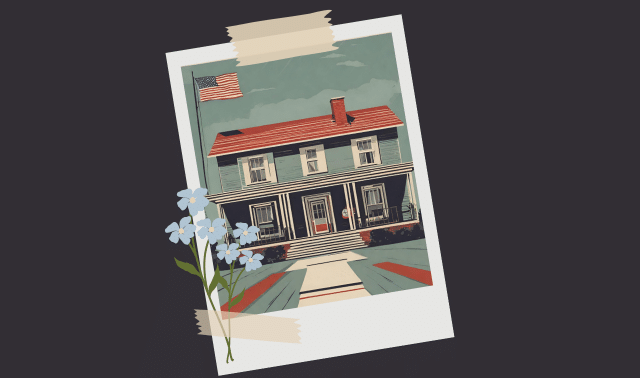Sign up for the Family Tree Newsletter Plus, you’ll receive our 10 Essential Genealogy Research Forms PDF as a special thank you!
Unless your ancestors were wealthy, it’s unlikely they had a lawn until the 1870s or even later. The word “laune” first appeared in 1540, though the aristocracy in northern Europe were surrounding their castles with grassy swards in the Middle Ages. Upwardly mobile landowners in America adopted the idea, and both George Washington and Thomas Jefferson had lawns. Those grassy pleasures were out of reach, however, for ordinary folks.
The problem was how to keep lawns neatly trimmed. One labor-intensive option was to employ workers with scythes and shears. A more affordable alternative was to maintain sheep, horses or even rabbits who would graze your lawn. In New York City, for example, a flock of 200 sheep—tended by a shepherd who lived in the building that later housed the Tavern on the Green—mowed Central Park.
But for the homeowner of modest means and little skill in animal husbandry, a lawn was impractical until Edwin Beard Budding came along and invented the lawn mower. A machine at a carpet factory inspired Budding, an engineer in England, with its spinning barrel of blades that evenly trimmed the fabric. He adapted the concept to “a new combination and application of machinery for the purpose of cropping or shearing the vegetable surfaces of lawns, grass-plats and pleasure grounds.” In Budding’s 1830 patent, he added, “Country gentlemen may find in using my machine themselves an amusing, useful and healthy exercise.”
Budding’s lawn mower—not so different from the human-powered reel mowers of today—made its debut at Regents Park Zoo in London. Budding and a partner, John Ferrabee, licensed the technology to other companies. One was Ransomes, which has been making mowers since 1832 and today is the world’s leading manufacturer of lawn-care equipment.
When Budding’s patents began to expire, others got into the business. Budding’s mower used gears to transfer power from the rear roller to the cutting cylinder. In 1859, Thomas Green and Sons of Leeds replaced the noisy gears with lighter, quieter chains and introduced the Silens Messor (Latin for “silent reaper”). An immediate success, the basic Silens Messor design remained in production until the 1930s.
The first US patent for a reel lawn mower was issued to Amariah Hills in 1868. But it was Elwood McGuire of Richmond, Ind., who first designed a push mower for the masses, in 1870. It was lighter, with fewer moving parts, and easier to push. By 1885, the United States was producing 50,000 lawn mowers annually and exporting them to lawns around the world.
Still, however, mowing depended on human power—or, literally, horsepower. Typically a horse pulled a “Pony mower,” with the operator walking behind; often an apprentice helped guide the horse. Its hooves might be covered by leather boots or slippers to protect the grass. (There was still, however, the issue of pony poop.) Sometimes the operator rode behind the mower in a sort of cart—the first “riding mower.”
It’s said that the Atco Standard, the first successful motorized mower, was invented in 1921 after a pony that had pulled the mower of a company director died. Instead of investing in a new horse, the director suggested Charles H. Pugh Ltd. try to build a gasoline-powered mower.
Atco’s successful powered mower was far from the only breakthrough when the end of World War I allowed people to think about lawns again. As engines became more powerful, inventors experimented with rotary cutting blades. Golf’s popularity led to specialized equipment for maintaining fairways and greens: In 1920, the Minikahda Country Club in Minneapolis approached the Toro Manufacturing Co. to come up with a motorized fairway mower. The solution—mounting five lawn mowers onto the front of a Toro tractor—helped create the motorized golf-equipment industry.
In 1938, Toro introduced the Homelawn, marketed as the first power mower for the average homeowner. Another world war intervened, however, and not until the postwar suburban sprawl crawled across the landscape did power mowers broadly replace push mowers.
Toro’s chief competitor for dominance of the American lawn, Lawn-Boy, had first appeared in 1934 as a brand of the Evinrude Co., known for its outboard motors. Evinrude introduced the Lawn-Boy as the nation’s first one-handed reel power mower. But with America’s entry into World War II, Evinrude’s production was diverted to outboard motors for the military.
Lawn-Boy went through several changes of ownership until finally hitting its stride in the 1950s. In 1952, the company purchased a rotary power mower that Jack Doyle had designed a few years before. Doyle had found success selling his mowers through catalog companies such as Sears, Roebuck and Spiegel. Painted a distinctive blue-green with red fuel tanks, the new Lawn-Boy mowers quickly made their mark on American lawns.
US sales boomed from about 140,000 in 1946 to 1.2 million mowers annually just five years later, and 4.2 million in 1958. By 1961, power lawn mowers were at last so ubiquitous that agronomist C.B. Mills observed, “Today, if all of them in a single neighborhood were started at once, the racket would be heard ’round the world.”
Inventors continued to change the world of lawn care. In 1963, the John Deere Co. of Moline, Ill.,, known for its farm equipment, ventured into the consumer market to sell lawn tractors with mower attachments. The riding lawn mower was now within reach of the horseless homeowner.
In 1964, inspired by the newfangled Hovercraft, Karl Dahlman invented a hover mower that floated above the grass as it cut. Dahlman’s creation won the gold medal at the International Inventors Fair in Brussels. The next year the Flymo went into commercial production.
Nowadays, the latest thing in lawncare is the ZTR riding mower, short for “zero turn radius.” Powered front wheels let these lawn mowers spin and turn with the ease of a ballet dancer. The idea originated with Phil McCrackin in 1945 for a walk-behind mower, and in 1955 for a riding mower. But zero-turn mowers didn’t really catch on until John Regier developed a hydraulic version in 1963—dubbed The Hustler, after a B-58 bomber he’d seen in Popular Science magazine. Regier’s invention was inspired by his wife, who was sick of cutting the grass at their Moundview, Kan., home.
It’s a good thing for today’s lawn lovers that Regier didn’t just get some sheep.
Timeline
1830 | Edwin Budding patents the first lawn mower
1859 | Silens Messor replaces gear drive with chain
1902 | Ransomes builds a petrol-powered mower
1921 | Atco Standard popularizes the power mower
1948 | Toro acquires Whirlwind, a maker of rotary mowers
1965 | The Flymo is introduced
1968 | Toro markets first key-start home mower
1989 | Toro acquires rival Lawn-Boy
1992 | The Lawnmower Man film is released
2001 | Pollution from a lawn mower estimated to be four times that from a car, per hour
Early lawn mowers were built with two handles, as the cast-iron machines were so heavy they required a pair of operators.
Colonel Edwin George built America’s first gas-powered lawn mower, the “Moto-Mower,” in 1919
in Detroit.
In 1893, Englishman James Sumner patented the steam-powered lawn mower—but it took longer for the steam to build up to operating pressure than it did to mow a lawn.
From the May/June 2012 issue of Family Tree Magazine




